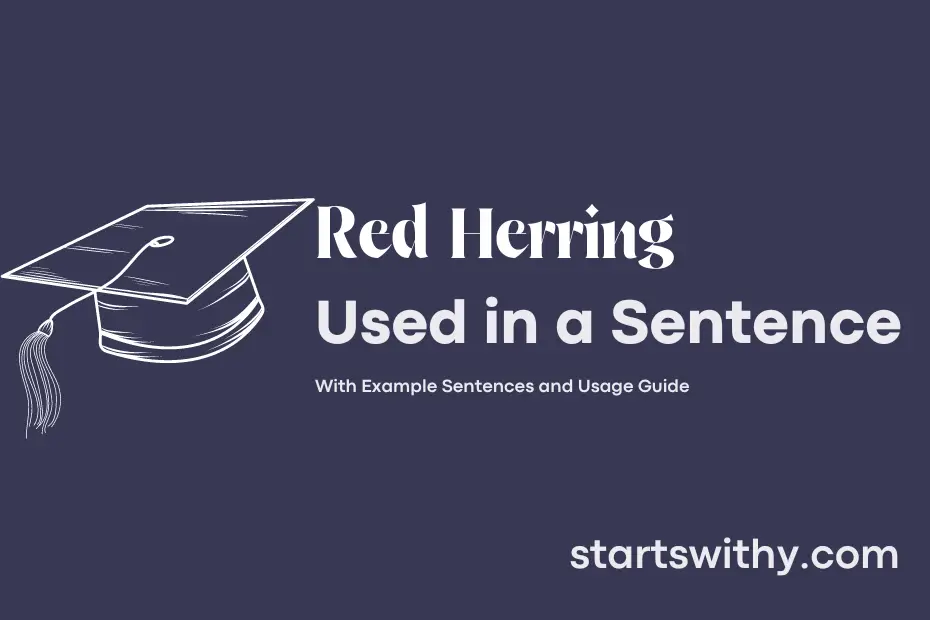Ever been led astray by a misleading clue that takes you in the wrong direction? That’s the essence of a red herring. In literary and logical contexts, a red herring is a tactic used to divert attention away from the real issue or point being made.
Often appearing in mysteries, debates, or arguments, a red herring can be a subtle distraction or a blatant misdirection that shifts focus away from the main topic. It serves to confuse or mislead, making it a clever and sometimes deceptive tool in storytelling and persuasion.
7 Examples Of Red Herring Used In a Sentence For Kids
- The red herring swam fast in the ocean.
- I found a shiny red herring in the sand.
- The red herring has a slippery body.
- A big red herring jumped out of the water.
- The red herring wiggled and splashed around.
- The red herring likes to hide in seaweed.
- I saw a group of red herring swimming together.
14 Sentences with Red Herring Examples
- During the debate competition, the speaker cleverly used a red herring to divert attention from the main argument.
- The professor included a red herring in the quiz to test if the students were paying attention to details.
- In the group project discussion, one member kept bringing up irrelevant points as a red herring to avoid addressing the main issue.
- The marketing presentation was filled with red herrings to distract the audience from the product’s shortcomings.
- During the job interview, the candidate used a red herring to avoid answering a difficult question.
- The political speech was filled with red herrings to confuse the listeners and manipulate their opinions.
- The student council meeting was derailed by a series of red herrings brought up by a member with ulterior motives.
- The research paper was criticized for including unnecessary red herrings that did not contribute to the main argument.
- The debate team strategically used red herrings to throw off their opponents and secure a victory.
- The class discussion was disrupted by a red herring raised by a student who was trying to change the topic.
- The panel discussion turned into a heated argument when one panelist accused another of using red herrings to mislead the audience.
- The student’s essay was criticized for including too many red herrings that detracted from the overall thesis.
- The campus debate club workshop focused on identifying and countering red herrings in arguments.
- The mock trial competition challenged participants to recognize and call out red herrings used by the opposing counsel.
How To Use Red Herring in Sentences?
Red Herring is a type of fallacy that involves misleading or distracting information intended to divert attention away from the real issue or argument. In writing or conversation, using a red herring can confuse or mislead the audience, leading them to draw incorrect conclusions.
To use red herring in a sentence, identify a situation where someone is deliberately introducing irrelevant information to mislead others. For example, “During the debate, the politician’s response seemed like a red herring as he dodged the main question and shifted the focus to a different topic.”
In this sentence, “red herring” is used to highlight the tactic employed by the politician to deflect attention from the original question. By using this term, the speaker is pointing out the attempt to deceive or mislead the audience by introducing unrelated information.
When incorporating red herring into your writing or speech, make sure to provide context or clarification on how the misleading information is being used to distract from the main topic. By using this term effectively, you can help others recognize when misleading tactics are being used in discussions or arguments.
Conclusion
In conclusion, red herring sentences are used to distract or mislead readers by introducing irrelevant or misleading information in writing. These sentences are designed to divert attention from the main topic or argument at hand, often leading the audience to draw incorrect conclusions or lose focus on the primary message. By recognizing and avoiding red herring sentences, writers can ensure that their communication is clear, concise, and on point.
It is essential to remain vigilant and critical when reading or writing to identify potential red herrings and maintain the coherence and integrity of the intended message. By staying focused on the main idea and avoiding unnecessary tangents or misleading information, writers can effectively convey their thoughts and ideas without confusing or misleading their audience.



